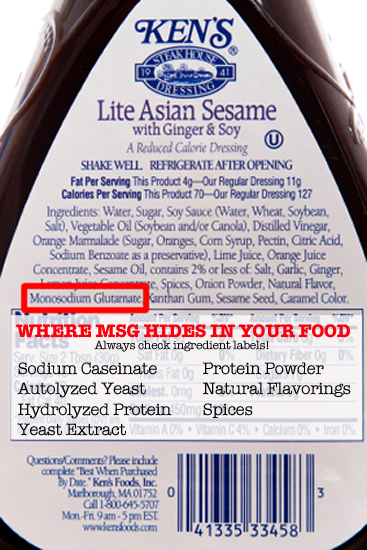It’s in ranch dressing, Doritos, canned soups, and french fries. You’re eating it if you go to KFC, have green bean casserole, or take a swig of Diet Coke. Really, any processed food likely includes some form of it. What is this ubiquitous food product? Monosodium glutamate, most commonly known as MSG.
For years, MSG has been the subject of debate. The Food and Drug Administration calls it safe, MSG-sensitive persons think it causes headaches and asthma, and scientists show conflicting research on the effects of MSG. What’s the truth? Should everyone stop eating it? Are the food companies and government in conspiracy against the public? Or is this product a safe and healthy flavor enhancer?
First, it is helpful to go over what monosodium glutamate is. MSG is added to foods to enhance flavor without giving a flavor of its own, according to the FDA. It was first discovered in Japan in 1908 by a scientist named Ikeda, who isolated the compound after wanting to know the secret of his wife’s delicious soup. Along with branding his product and making millions, he also came up with the idea of umami, a fifth taste translated as savory or deliciousness that is distinct from the senses of sweet, sour, bitter, and salty.
Umami makes up the taste in naturally occurring MSG, or free glutamic acid, and is highly concentrated in things like tomatoes, mushrooms, and cheese. Processed glutamic acid found in MSG is made from the salt of the natural glutamate. It can be added in pure form by brands such as Aji-No-Moto (the company Ikeda started) or as the major ingredient in seasonings such as Accent.
In the 1960s, years after MSG had been introduced to America, people started becoming concerned about MSG when reports of the so-called Chinese Restaurant Syndrome began to surface. After eating Chinese food, a cuisine in which MSG is liberally used, sufferers reported symptoms such as headaches, chest pain, numbness, or a sense of weakness that lasted several hours, with people calling it the “MSG buzz.”
Soon, the additive was ostracized, blamed for more than just a buzz. Research at the time showed that MSG could cause brain damage in infants so it was removed from baby foods. Many products and restaurants soon carried the label “No MSG” to ease worried consumers’ minds. People then and still blame it for causing everything from autism to hyperactivity and sites such as msgtruth.org and truthinlabeling.org dedicate themselves to educating the public about its harmful effects.
MSG has not been defeated yet; in fact, we’re far from it. Although manufacturers are required to list monosodium glutamate in their ingredients if they use the pure form, it can easily be hidden in another ingredient. Sodium caseinate, autolyzed yeast, hydrolyzed protein, yeast extract, and protein powders all contain MSG. Catchall terms such as “natural flavorings” and “spices” also more than likely contain the additive.
There is a discrepancy between research studies done about MSG and its possible effects. Both sides on the issue can cite numerous articles about its safety or toxicity. Our resident nutrition expert, Mary Hartley, RD said, “The FDA recognizes MSG as safe, although because of inherent limitations of science, the FDA maintains that they can never be absolutely certain of the absence of any risk from the use of any substance.”
Many studies involving MSG consumption used rats as subjects instead of humans. However, “several double-blind placebo controlled studies have been performed using capsulated MSG, since it has a distinct flavor, all of which have consistently failed to show increased incidence of adverse effects from MSG doses as high as five grams. Additionally, there is no convincing link between MSG and asthma or obesity in controlled trials,” said Yadon Arad, MD and Chief Nutrition Officer at wHealthySolutions.com.
One concise study in support of MSG was done by the International Food Information Council Foundation and cited the fact that the World Health Organization, United Nations Food and Agriculture Organization, European Community’s Scientific Committee for Food, and American Medical Association all deem MSG as safe for the general population.
Like any food product, some are allergic to MSG and react violently to the additive. A 1991 segment of 60 minutes about MSG gave estimates that two percent of the population, which equates to millions of people, are allergic to MSG. Many simply do not know that it is MSG that is making them sick or they just attribute their symptoms to something else.
Even if you don’t have an allergy to MSG, Peggy Kotsopoulos, a registered holistic nutritionist and host of Kitchen Cures with Peggy K on Veria Living, told us, “Everyone should avoid MSG. Even though one might not have immediate symptoms, they can bioaccumulate in the brain overtime and may lead to long-term conditions such as Alzheimer’s.”
Susan Shenck, author of the Live Food Factor, also had no good things to say about MSG: “Excitotoxins” are toxic addictive chemicals, such as aspartame and MSG, commonly added to foods to ‘excite’ (unnaturally stimulate) the brain and nervous system. They trick the brain into thinking the food is delicious, deepening addiction while causing cumulative damage to the nervous system over many years.”
But then others question those beliefs, like Alex Renton’s entertaining 2005 article in The Observer entitled, “If MSG is so bad for you, why doesn’t everyone in Asia have a headache?”.
So the jury is still out, and may be for a long time, about MSG. Although Chinese Restaurant Syndrome has been largely disproven as more of a mass hysteria effect than real problem, that doesn’t mean MSG should be sprinkled over everything. One thing is obvious – most of the foods MSG is in are not healthy choices for anyone and should be avoided on that basis alone. Eating real, whole foods will always be better than bland processed ones that have been dressed up to taste better with MSG.
Also Read:
8 Chemical Food Additives You Should Avoid
